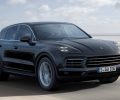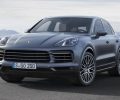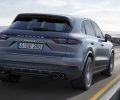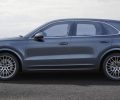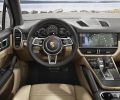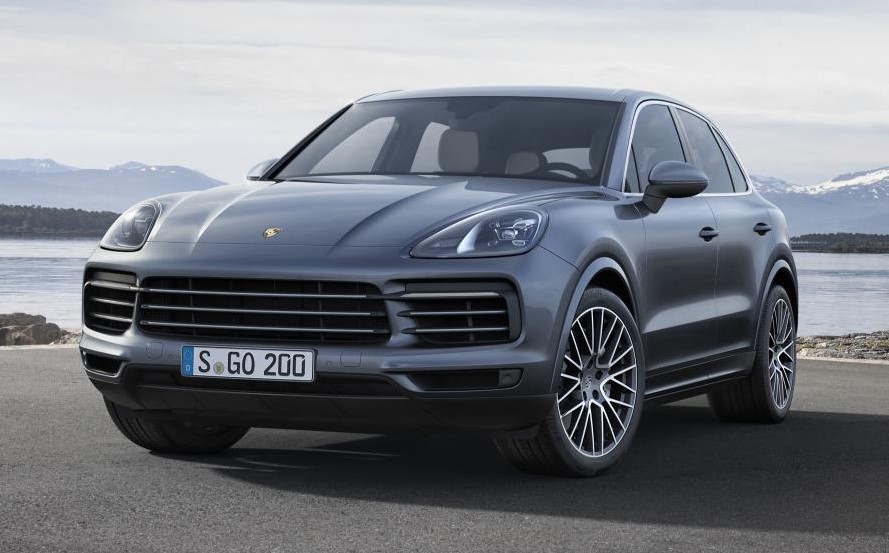
THIRD GENERATION
New engines, new chassis, innovative control concept, and increased connectivity
- Two models available at launch: Cayenne and Cayenne S
- Cayenne: 3.0L single-turbo V6 with 340 horsepower, 332 lb-ft of torque
- Cayenne S: 2.9L twin-turbo V6 making 440 horsepower, 406 lb-ft of torque
- Porsche Traction Management (PTM) AWD Standard across model line
- New eight-speed Tiptronic S gearbox
- Intensive use of aluminum reduces weight vs. previous generation
- Available rear-axle steering increases agility and stability
- First model to offer new Porsche Surface Coated Brakes (PSCB)
Atlanta, Georgia. Today Porsche unveiled the new 2019 Cayenne. The all-new Cayenne builds on the formula that started in 2003 while pushing performance boundaries even further through new technologies that significantly improve on-road performance and comfort. The new Cayenne is more athletic both in appearance and driving performance due to new styling cues and engineering developments. In line with its modern exterior, the interior carries many of the same design cues and new technologies that made their debut on the 2017 Porsche Panamera.
Among the many changes, optional rear-axle steering creates a virtual reduction of the wheelbase at low speeds and a virtual lengthening at high speeds for improved agility and stability. Available Porsche Surface Coated Brakes (PSCB) offer even greater stopping power and reduced brake wear. Every new generation Cayenne model will come with a turbocharged powertrain and all-wheel drive that complement the new lighter weight platform.
Performance: New Powertrains and Standard Equipment
Porsche will offer two models at launch: the Cayenne and Cayenne S. Both are powered by turbocharged six-cylinder engines. The Cayenne uses a 3.0-liter single-turbo V6 making 340 horsepower and 332 lb-ft of torque, enabling it to accelerate from zero to 60 mph in 5.9 seconds (or 5.6 seconds with the optional Sport Chrono package). The new Cayenne is also capable of running the quarter-mile in 14.4 seconds or 14.2 seconds with the Sport Chrono package, and it is able to reach a top track speed of 152 mph. The Cayenne S uses a 2.9-liter twin-turbo V6 that makes 440 horsepower and 406 lb-ft of torque. It is able to accelerate to 60 mph from a standstill in 4.9 seconds (or 4.6 seconds with the optional Sport Chrono package) and continue on toward a top track speed of 164 mph. The Cayenne S quarter mile times drop to 13.3 seconds (or 13.2 seconds with the Sport Chrono package).
A newly-developed eight-speed Tiptronic S transmission is standard across the Cayenne line. It offers improved comfort and quicker response times in its lower gear range for improved performance both on- and off-road. Meanwhile, an intentionally long eighth gear allows for relaxed cruising. The long gear is designed to complement the performance-minded lower ratios with the option for comfortable highway cruising. Driver-selectable transmission programming further enhances how the Cayenne handles on varied terrain. The default setting is the on-road program. Four other modes activate the conditioning for mild off-road terrain: Mud, Gravel, Sand, or Rocks. The drive mode, chassis settings, and differential locks can be selected to adapt to the relevant scenario. Fully variable Porsche Traction Management (PTM) all-wheel drive is standard on all Cayenne models. The system offers excellent performance characteristics while also providing extensive traction on rough ground.
Chassis: Fundamental Improvements Start With Structure
The third-generation Cayenne has a newly-developed lighter weight chassis that contributes to an overall weight savings of up to 143 lbs versus the previous generation, even with extensively increased standard equipment. Following the Porsche 911 and Panamera models, the new body of the Cayenne also uses an intelligent combination of alloy and steel. The exterior is made almost entirely of aluminum as are the floorpan assembly, front section, and virtually all the chassis components. One particular technical highlight is the innovative lithium-ion polymer starter battery, which alone accounts for a weight saving of 22 lbs.
Compared to its predecessor, the new Cayenne incorporates major technological and mechanical developments which greatly enhance performance. This starts with the chassis and progresses to a separated link design for the front axle, a multilink rear axle, and – for the first time with the Cayenne – staggered front and rear tire sizes ranging in diameter from 19 to 21 inches that help to improve on-road driving dynamics. The choice to use a staggered tire setup in this generation underscores the fact that the Porsche Cayenne is designed to be the sports car within its segment.
Enhancing both agility at lower speeds and handling at high speeds, rear-axle steering is available as an option. This technology reduces the turning radius at low speeds for easier maneuverability by turning the rear wheels out of phase with the front axle. At higher speeds, the rear wheels turn in phase with the front axle to provide a virtual lengthening of the wheelbase to improve roadholding and directional control.
Porsche Active Suspension Management (PASM) offers familiar variable damping settings found in other Porsche cars. It will be standard equipment on the Cayenne S and an option on the Cayenne. In addition to PASM, a new three-chamber air suspension is also optionally available which furthers the range of comfort- and performance-oriented settings. The new system increases air volume versus the previous system and offers a finer degree of specific calibration through the addition of a third air chamber. Finally, available Porsche Dynamic Chassis Control (PDCC) adds stabilizer bars that are now controlled via a 48-volt electrical system for greatly improved responsiveness versus hydraulic management.
When equipped, all of those systems generate data that are analyzed centrally, in real time, by Porsche 4D Chassis Control. This technology debuted with the second-generation Panamera. The system works to make virtually instantaneous adjustments, optimizing handling even further. With the exception of the active PASM damper system, all other chassis systems are new developments.
Dynamic design language: wider appearance and larger wheels
The new Cayenne retains a strong visual connection to its predecessors. At the same time, it adopts new design elements that hint at how this generation builds upon its predecessors. New horizontal light edges create a wider, more athletic appearance as do enlarged air intakes in the front fascia. The wheelbase remains unchanged at 114 inches, while overall length increases slightly to 194 inches and width (with side mirrors folded) is 78 inches. Cargo area volume with the rear seats raised increases by almost 15 percent over the previous generation to 27.19 cubic feet. When closed, the rear fascia features a new three-dimensional LED light design that features the Porsche logo spanning the width of the vehicle through a narrow strip of lights.
Broadly speaking, LEDs are a main feature of the new Cayenne and are standard on all models. Customers may also choose to upgrade from the standard headlights to either the Porsche Dynamic Light System (PLDS) or LED Matrix Beam headlights, which also include PDLS.
World premiere: Porsche Surface Coated Brake with tungsten-carbide layer
Porsche Surface Coated Brake (PSCB) technology is the latest example of Porsche assuming a pioneering role in developing high performance brakes. This world-first is available as an option for all Cayenne models and consists of a cast-iron disc with a tungsten-carbide coating. The finish increases friction values while reducing wear and brake dust. The brakes – which are exclusive to Porsche – will take on a visually impressive glossy appearance complemented by white painted calipers. The PSCB system is only available in combination with 20-inch and 21-inch wheels. The Porsche Carbon Ceramic Brakes (PCCB) remain the top system available.
New Sport Chrono Package with PSM Sport
The new Cayenne utilizes the redeveloped Sport Chrono Package which reflects the design first employed in the 918 Spyder. The Mode button on the steering wheel is one clear indicator of this approach. As well as the Normal, Sport, and Sport Plus driving modes, the driver can select an individually configurable mode. Pressing the Sport Response button in the center activates the most performance-oriented engine and transmission mapping for 20 seconds. The Sport Chrono Package also includes a separate PSM Sport mode, in which the driver can utilize a wider range of the new Cayenne’s driving dynamics.
Digital evolution: Porsche Advanced Cockpit and new PCM
The newest version of Porsche Communication Management (PCM) makes its way into the new Cayenne, ushering into the model line a new level of connectivity. At the heart of the new display and control concept from Porsche is the 12.3-inch full-HD touchscreen, launched last year with the new Panamera.
A range of digital functions can be operated intuitively through touch and also voice controls. The standard Porsche Connect Plus allows subscribers to have access to services including online navigation with real-time traffic information. The analog controls on the new center console are focused on the main functions of the vehicle. Other buttons are integrated into the smartphone-like, glass-look touch surface, which gives acoustic and haptic feedback when operated. In typical Porsche style, the driver has a central analog tachometer to view. This is flanked by two 7-inch full-HD displays showing relevant driving data that can be selected and changed using the multi-function steering wheel. Cayenne customers may specify a variety of available assistance systems as well that include Night Vision Assist, which uses a thermal imaging camera to detect pedestrians and animals before they are visible to the naked eye. Lane Change Assist, Lane Keep Assist including traffic sign recognition, traffic jam assist, ParkAssist including Surround View, and Porsche InnoDrive including adaptive cruise control are also available.
PCM also offers the ability for a great degree of customization by saving preferred settings and menu layouts including up to six individual profiles. In addition to a large number of interior settings, a profile is used to store specifications for lights, driving programs, and assistance systems. Depending on the equipment, each driver can also apply his or her own settings to the new sound systems from Bose® and Burmester®.
A new Off-road Precision App, specially developed for the Porsche Cayenne, is now also available as part of Connect Plus. It allows rough-terrain drives to be documented in detail, helping the driver to improve her or his own skills using video recordings.
Pricing and U.S. market availability
The 2019 Cayenne and Cayenne S models are available to order with a base MSRP of $65,700 and $82,900 respectively, excluding the $1,050 delivery, processing and handling fees. They will reach U.S. dealers midway through 2018.


